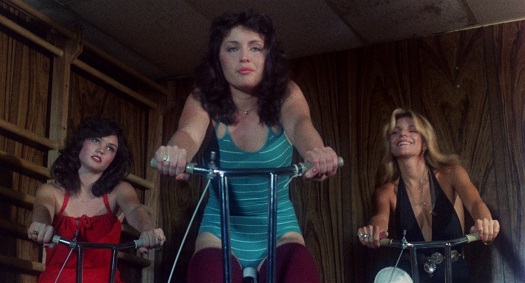Midnight Confessions #05: The Pink Ladies (1979)

- You’re a kid Casanova, you’re no Joseph
It’s a labor of love fucking yourself to death
Orgasm addict, you’re an orgasm addict
(Buzzcocks – Orgasm Addict)
Just paddling along an imaginary current of thought – not necessarily the first thing that springs to mind when pondering about pornographic cinema. Thought – a word too flexible, too impalpable for a genre, at least according to long standing sentiments, focussed on far more rigid currencies – concrete images designed to stimulate not your imagination but your loins. Notorious NYC underground auteur Roger Watkins‘ second feature past crossing over into pornography is a film focussed entirely on the imagination, yours and the characters‘ alike. Mind you, that’s not a fancy worded way to imply an utter lack of graphic sex but an description of the tender bond between people on and of the screen Watkins weaves. Barring the finale, every single sexual encounter in his film is a fantasy designed around you joining right in a given dreamers inner flow or not. Feeling their excitement as your own or remaining just a spectator in awe of a precise deconstruction of urban craving American style – these are the choices Watkins presents us with and both work just fine. A testament to the effectiveness of a rather unusual construction method seemingly mirroring Watkin’s own thought process while tasked with creating a film he would later wholeheartedly dislike. The contrast couldn’t be more pronounced: While most of his work relies strongly on the trademark stark narratives he is mostly remembered for, „The Pink Ladies“ is more of a filmlength association game, stream of consciousness storytelling translated into film and not as a mere conversion of any given piece of literature penned in this fashion but the narration device itself. If the majority of Watkins‘ work is a filmic take on the Southern Gothic devotee’s favorite author Carson McCullers, her madcap dark cravings and societal nightmares, this is more of a William Faulkner movie – had Faulkner scrawled just the basic association hubs for a pornographic film on a napkin instead of in a fully fleshed out script.

It all begins just like the sort of film fellow New Yorkian pornographer Roberta Findlay was already doing almost a decade before. Accompanied by Emerson, Lake & Palmer’s famous rendition of „Fanfare for the Common Man“ a group of women engages in a tennis match whose intensity is gradually increased by drummer Carl Palmer’s strong grip on the montage more than any extraordinary talent at the racquet. A man – who might or might not be a coach – intently gazes on the participants while his and our own angles blend together fast and faster. Bouncing a ball, catching a ball, missing it, picking it up, grabbing a sneaky cock. No, that’s him masturbating to them taking a shower. Keith Emerson goes wild on his GX-1, upping the pressure and reassuring us that we’re still in a quasi-Riefenstahlian sports montage. Suddenly, just as distinctly flutelike sounds morph into the more aggressive part of his bewildering modal solo, that certain flute on screen is obviously threatening to blow up as well. Cut – a fantasy sequence ensues and finally delivers „real“ intercourse. Manual operation mode as a prelude to imaginary ecstasy, thoughts flying wild to the sacral combination of music and masturbation. Sex is sport and sport is sex, the structure of Watkin’s unhingend, hyperbolic montage actually mirrors the act of frantically beating your meat to pulp quite well. Intellectualized pocket pool, a fanfare to the common masturbator – that’s just what „The Pink Ladies“ is in a nutshell.

„I’m watching a ball game!“, exclaims Robert Kerman to his wife, slouching on the couch, a newspaper spread out in front of his face and likewise the cadrage. Discernible amidst mostly non-legible words: Sports, boxing, baseball, the American game, hitters frozen in ink. Discernible on the sound track: A radio commentator describing a match. The discrepancy between the moving and the stationary is crucial to Watkin’s methodic. A tad later Kerman will channel some spiritual energy to transport himself into another dreamscape, the room of a girl he likes to peep on. Plastered over the bed is Humphrey Bogart brandishing a loaded gun. Another one of these is simultaneously buried in Marcia Minor’s crotch and it goes off just as the musical pressure and an insisting close up on Bogart’s cold, manly steel drive Kerman over the edge. Different characters seem to have different objects of comparison hardwired into their mental processes. Robin Byrd is stunned by a ferris wheel going round and round on TV as she fantasizes about a bulky strongman blowing air into his thus swelling appendix. Entirely new fanfares introduce tricks by another circus artist and a third – an evolving cabaret of lust. Evolving – Alan Adrian’s masturbating hand slips off his cock to signify a change of universes, then the accoustic undercurrent grows to resemble canned music more and more, he is obviously dozing away. Music is less of a magnetic force field gently guiding each and every decision, gesticulation or thrust like in Roberta Findlay’s cinema and more of an internalized surge, a head canon best visualized as an radio encapsulated in your brain whose frequencies you can twist any way you like by just a flicker of wandering thought. Sometimes these frequencies are able to locate an opening and just pour out of their hull. When his girlfriends knocks on the door, Adrian replies by singing to her and she returns the favor, back and forth, until both gain enough momentum to end up in an extended SM fantasy set to Iggy Pop’s soothingly unreal „Sister Midnight“.


In the film’s centerpiece these mind, soul and sound waves are further elaborated upon. Fittingly set in a train station, the scene focusses entirely on directions, ways and whys of travelling desire. Unsatisfied husbands or boyfriends Adrian, Kerman, Michael Gaunt and Jesse Adams spy on Vanessa del Rio who is seated vis-a-vis across the tracks. Gradually she’s made aware of their oggling through intercut faces and every man is consequently granted a unique wet daydream of his own. In between glances – acknowledgement, the montage states it bluntly: Everyone is fully aware of each other, their desires, their naughty contemplation. A delicate hive mind – dreaming as communication device, thought currents behind the all American facade. Four vignettes, one soundscape. While all sound is drained out at the station, it effortlessly evolves in these imaginary chambers, an endless stream centered around an acoustic interpretation of Gershwin’s „The Man I Love“. Through careful editing a new instrument takes the lead alongside each new lover. Music is what seperates the subconscious from reality, but in your head osmosis of the minds reigns surpreme. The most intricate orgy of Golden Age pornography – the four guys might be on their own spatially speaking, but they’re all inside Vanessa del Rio at the same moment in time. A strange array of mismatched people for most of its running time, „The Pink Ladies“ suddenly turns quite bold in the implications of this group encounter: „The Seductress“ – and that’s precisely the role del Rio’s credited with – finds exactly what she’s looking for while the titular girls are stuck with far more obvious and far less expansive fantasies, she is (like most characters portrayed by del Rio across Watkins‘ cinematic landscape) neither part of their world nor America as a whole.

No doubt about it – that’s precisely what Watkins‘ satire is taking aim at. America as a whole. A shitwhole. His yuppie characters can’t get off properly in everyday life, for they are too obsessed with appearances. What Robin Byrd’s earlier fantasy sequence only hinted at – you can’t help but notice that the body she’s flaunting appears even more sculpted and perfect than the ones of her male co-artists – rushes to the foreground in Watkins‘ once more supremely body centric climax. While working out at a gym, a sudden storm in form of Wagner’s notorious „Walkürenritt“ gathers and unleashes its malign influence on three of our four valkyries. Deadly serious they pedal like mad on exercycles, their wiggling butts forming a tender undercurrent to the pompous clangour, closely watched and utterly ridicolous at the same time. It is precisely here where the more or less subtle jabs grow into sardonic laughter. Sheet music acting as a suspense curve causes everyone around to first lose their ludicrous spandex clothing for some final orgy and then sets its participants on ride to hell complete with a devil incarnate. All the while – copious motion but no progress of any kind; people riding, fucking, pumping iron, but only to an otherworldly stream of teutonic romanticism not any real increase in tempo. Exercise – the religious idol of the 1980’s – is never enough, just an empty promise of future grandezza.
The end, a dream, the underworld? In a way. Christine de Shaffer who got the boot for her perceived shortcomings before the group’s final journey is watching the river flow, but beneath the tranquil surface a veritable underwater ballet goes on. Intercut glances – or are they just now in-character associations – at the now aquatic shenanigans. Her eyes are ours, piercing the thoroughly unsatisfied underbelly of American life. A gaze, a drifting basket, readjust your sight parameters and suddenly the piece of wood reveals three floating dead swans. Prime surrealism, a snide, downright vicious remark. While the above mentioned Roberta Findlay’s structurally similar films lack concrete political ideas or even full-blown agendas in favor of a unique, more poetical and abstract humanist-pessimism, Roger Watkins was always one to wear his heart on his sleeve. Even the music, force field supreme in both oeuvres, has a biting instead of softly encouraging ring to it. Like most of his films – and especially the nominally more exuberant ones – this is a nihilist caricature of modern society, sharp and dolorous like the most underground of internet memes. Watkins truly was a pioneering troll, one gifted with radical insight and brilliant humor, but a troll nonetheless. Domesticated house pigs wanking their pizzles torn between primitive craving and crude relief, that nasty final gag which sees the girls returning home after all just to witness de Shaffer „cucking“ them with all the guys, ambivalences and acrimonious expression – its all there just waiting for your own input. Are you swallowing the bait or are you not? „The Pink Ladies“ is the kind of film that, in a strictly inferior world, should prove popular with incel communities – but dead keen on approval as they are, they’d still only grasp about a sliver of its sardonic richness.

The Pink Ladies – USA 1979 – 77 minutes – Direction: Roger Watkins (as „Richard Mahler“), Robert Michaels – Production: Robert Michaels – Screenplay: Roger Watkins (as „Richard Mahler“) – Cinematography: ? – Editing: Roger Watkins (as „Richard Mahler“), Erica Havens – Music: Emerson, Lake & Palmer, George Gershwin, Iggy Pop, Richard Wagner – Cast: Christine de Shaffer, Kandi Barbour, Samantha Fox, Robin Byrd, Vanessa del Rio and many more
[…] – aber Ausnahmen mache ich auch gerne mal). André Malberg hat sich auf Eskalierende Träume mit Roger Watkins’ Erwachsenenfilm „The Pink Ladies“ beschäftigt. Das ist doch ein guter Abschluss für dieses […]